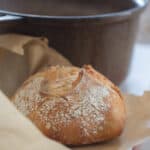
How to Make Small Batch Sourdough Bread
If you can't ever seem to make it through an entire sourdough loaf before it goes bad, this small batch sourdough bread recipe is for you!
Servings 12
Calories 77kcal
Ingredients
- 240 grams all purpose flour
- 50 grams sourdough starter bubbly and active
- 165 grams water
- 5 grams salt
Instructions
- Before you plan to make sourdough bread, you'll want to feed your starter, ensuring it is nice and bubbly and active. Typically, this will be 4-12 hours before you begin your bread.
- Set a medium sized mixing bowl on a digital kitchen scale and add your ingredients - warm water, active starter, salt, and flour.
- Mix everything together using a dough whisk, wooden spoon, or your hands.
- Cover the bowl with plastic wrap or a lid and allow the dough to rest for 30 minutes. This is a process called autolyse, meaning the water is hydrating the flour.
Stretch And Fold
- To strengthen the gluten in your dough, you will perform a series of stretch and folds. This is a critical step to ensure you get a beautiful open crumb.
- Complete 3 rounds of stretch and folds, 30 minutes apart.
- To do a stretch and fold, grab the edge of the dough and pull up stretching it out as you pull upwards. This may be difficult and you may need to kind of bounce the dough to get it to stretch.
- Place dough that is in your hands back into the center. Turn the bowl about a quarter turn and complete another stretch and fold. Repeat two more times. This is considered one round.
Bulk Fermentation
- After the final stretch and fold, let the dough rest and continue to bulk ferment. Cover the bowl with a lid, damp kitchen towel, or plastic wrap.
- Let it sit in a warm place until the dough has doubled in size. This can take anywhere from 6 to 12 hours.
Shape
- Transfer dough to a clean floured surface.
- Fold the dough onto itself and roll up. Then shape into a ball by gently spinning it toward you.
- Let the dough ball sit uncovered for about 15 to 20 minutes to develop a skin
- Place the smooth side down and shape again. I do this by folding the two sides over to meet in the middle, pinch together and then repeat on the other two sides. This creates surface tension which helps give it more oven spring (a good rise).
- Place the dough in a small bowl with a floured tea towel. Make sure to place it seam side up, smooth side down.
- Cover with plastic or place in a plastic bag and tie the ends. Let the dough rest for 12 to 15 hours in the refrigerator.
Bake
- Preheat a dutch oven to 500 degrees for 1 hour.
- Remove dough from the fridge right before baking.
- Place dough on a piece of parchment paper (optional). Dust the dough with flour and score with a lame or razor blade.
- Carefully, transfer the piece of parchment paper with the dough into the hot dutch oven.
- Place the lid back on and place the dutch oven into the hot oven. Bake for 20 minutes.
- Carefully remove the lid with oven mitts, turn the oven temperature down to 475, and bake an additional 15 to 25 minutes or until golden brown.
Notes
- The dough ball will be too small for a regular size banneton. I recommend using a large soup bowl or a small stainless steel bowl. There are smaller bannetons you can purchase, but I personally like to just use what I already have.
- Bulk fermentation time can vary based on many factors, including the maturity of your starter and the temperature of your home. A smaller loaf will not proof faster just because of its size.
- Not sure how to tell when bulk fermentation is done? One trick is to let your dough rise in a glass container so you can easily see once it has doubled and can see if there are bubbles all over the dough. If you don't have a glass bowl that is the right size for your dough, take a small chunk of dough and place it in a jar. Flatten it down slightly in the bottom and mark where it reaches on the jar. Once this dough has doubled, the rest of your dough should be ready, too!
Nutrition
Calories: 77kcal | Carbohydrates: 16g | Protein: 2g | Fat: 0.2g | Saturated Fat: 0.03g | Polyunsaturated Fat: 0.1g | Monounsaturated Fat: 0.02g | Sodium: 163mg | Potassium: 21mg | Fiber: 1g | Sugar: 0.1g | Calcium: 4mg | Iron: 1mg